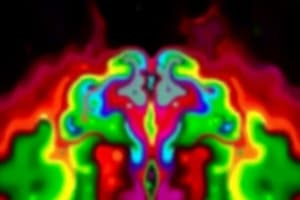Podcast
Questions and Answers
What is brain mapping?
What is brain mapping?
- The study of the anatomy of the brain using nanotechnology
- The process of creating a 2D map of the brain
- The study of the function of the brain using optogenetics
- The study of the anatomy and function of the brain and spinal cord using neuroscience techniques (correct)
What are the techniques used in brain mapping?
What are the techniques used in brain mapping?
- Stem cell biology, engineering, and neurophysiology
- Imaging, immunohistochemistry, molecular & optogenetics, stem cell and cellular biology, engineering, neurophysiology and nanotechnology (correct)
- Immunohistochemistry, optogenetics, and nanotechnology
- Imaging, immunohistochemistry, and molecular biology
What is the criticism of brain mapping?
What is the criticism of brain mapping?
- It can only study the anatomy of the brain, not the function
- It is not a reliable technique for studying the brain
- It makes claims about the brain that are not verifiable with the equipment used and based on an incorrect assumption that brain functions are divided into specific regions (correct)
- It is too invasive and dangerous
What are the limitations of brain mapping?
What are the limitations of brain mapping?
What can brain mapping be used for?
What can brain mapping be used for?
What are some significant milestones achieved by brain mapping?
What are some significant milestones achieved by brain mapping?
What is the drawback of studying brain functions by dividing the brain into specific regions?
What is the drawback of studying brain functions by dividing the brain into specific regions?
What can brain mapping be used to study besides the human brain?
What can brain mapping be used to study besides the human brain?
What are the areas of brain mapping that are constantly evolving?
What are the areas of brain mapping that are constantly evolving?
Flashcards
Brain Mapping
Brain Mapping
The study of brain and spinal cord anatomy and function using neuroscience techniques.
Brain Mapping Techniques
Brain Mapping Techniques
A variety of methods including imaging, immunohistochemistry, molecular & optogenetics, stem cell and cellular biology, engineering, neurophysiology and nanotechnology.
Brain Mapping Criticism
Brain Mapping Criticism
Claims made about brain function might not be verifiable and are based on assumptions about specific regions.
Brain Mapping Limitations
Brain Mapping Limitations
Signup and view all the flashcards
Brain Mapping Applications
Brain Mapping Applications
Signup and view all the flashcards
Brain Mapping Milestones
Brain Mapping Milestones
Signup and view all the flashcards
Dividing Brain into Regions Drawback
Dividing Brain into Regions Drawback
Signup and view all the flashcards
Brain Mapping Beyond Human Brain
Brain Mapping Beyond Human Brain
Signup and view all the flashcards
Evolving Areas in Brain Mapping
Evolving Areas in Brain Mapping
Signup and view all the flashcards
Study Notes
Neuroscience techniques are used to map the human or non-human brain, producing maps that are based on the mapping of biological quantities or properties onto spatial representations of the brain; brain mapping is defined as the study of the anatomy and function of the brain and spinal cord through the use of imaging, immunohistochemistry, molecular & optogenetics, stem cell and cellular biology, engineering, neurophysiology and nanotechnology. Brain mapping techniques are constantly evolving and rely on the development and refinement of image acquisition, representation, analysis, visualization and interpretation techniques. Brain mapping has been criticised for making claims about the brain that are not verifiable with the equipment used and based on an incorrect assumption that brain functions are divided into specific regions; many functions involve multiple parts of the brain and can only be described correctly after being measured with much more fine-grained measurements that look not at large regions but instead at a very large number of tiny individual brain circuits. Brain mapping is used to study the anatomy, physiology, perfusion, function and phenotypes of the human brain and can be used to understand traumatic brain injuries and improve brain injury treatment. Brain mapping has achieved some significant milestones such as the creation of the most comprehensive 3D map of the human brain, the first complete neuron-level-resolution 3D map of a monkey brain, and the first connectome that shows how an animal's brain changes throughout its lifetime. Brain mapping is also used to show the development of a mammalian neural circuit and to study brain regeneration.
Studying That Suits You
Use AI to generate personalized quizzes and flashcards to suit your learning preferences.




